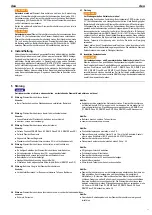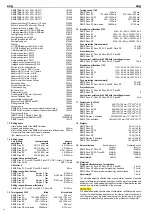
Translation of the Original Instruction Manual
Fig. 1 – 1
Fig. 1 – 13
Fig. 1 REMS Picus S1
Fig. 2 REMS Picus S3
Fig. 3 REMS Picus S2/3,5
Fig. 4 REMS Picus S1, REMS Picus
S3, REMS Picus SR,
manually controlled dry boring
with tapping tool
Fig. 5 Securing of drill upright
with plugs in concrete,
with knock-in anchor
Fig. 6 Securing of drill upright
with plugs in masonry,
with expansion anchor
(anchor sleeve)
Fig. 7 Machine rating plate,
REMS Picus S3
Fig. 8 Machine rating plate,
REMS Picus S2/3,5
Fig. 9 REMS Picus SR
Speed setting for
REMS Picus SR
Concrete/steel-reinforced
concrete
Masonry and other materials
Speed
Handle grip setting (39)
Dial setting (57)
Fig. 10 REMS Picus DP, hand-held
dry drilling with tapping tool
Fig. 11 REMS Simplex 2, mounting
water extractor unit
Fig. 12 REMS Titan, mounting
water extractor unit
Fig. 13 Accessories
1 Boring trestle
2 Feed slider
4 Feed lever (insulated grip surface)
5 Adjustment screws
6 Base plate
7 Slot
8 Fillister head screw
10 Clamping angle
11 Drive spindle
12 Counterholder (insulated grip)
Counterholder
Counterholder
13 Drill collar
14 Cover
15 Water supply system
16 Control lamp PRCD fault current
circuit breaker
17 RESET button
18 TEST button
19 PRCD fault current circuit breaker
20 Motor handle (insulated grip)
21 Safety inching switch
(REMS Picus S1, REMS Picus S3,
REMS Picus SR, REMS Picus DP)
21a Rocker switch
(REMS Picus S2 / 3,5)
22 Adapter
23 Knock-in anchor
24 Flattener
25 Knurled threaded rod
26 Washer
27 Fast-tightening nut
28 Expansion anchor
29 Grip head
30 Locknut
31 Screws
32 Wing nut
33 Threaded spindle
34 Fillister head screw
37 Hexagon head screw
38 Spacer set
39 Handle grip
40 Struts
41 Hose connection
42 Cover plate
43 Sealing ring
44 Water extractor unit
45 Rubber gasket
46 Suction rotor
47 Annular core bit connector,
UNC 1¼ and G ½
48 Diamond core drilling crowns
49 Tapping tool
50 Annular core bit extension
51 Water pressure tank
52 Screws
53 Guide
54 Quick-release ring
55 Whetstone
56 Bull’s eye level
57 Dial
58 Laser drilling centre pointer
59 Locking screw for earthing cable
60 Tapped hole
61 Clip
62 Quick clamp set 160
63 Quick clamp set 500
64 Drilling template REMS Titan
65 Carbide masonry drill Ø 15 mm
SDS-plus
66 Carbide masonry drill Ø 20 mm
SDS-plus
67 Vacuum pump
68 Suction hose connection
69 Micro-pulse technology
adjusting ring
General power tool safety warnings
WARNING
WARNING
Read all safety warnings, instructions, illustrations and specifi cations provided
with this power tool. Failure to follow all instructions listed below may result in
electric shock, fi re and/or serious injury.
Save all warnings and instructions for future reference.
The term “power tool” in the warnings refers to your mains-operated (corded) power
tool or battery-operated (cordless) power tool.
1) Work area safety
a) Keep work area clean and well lit. Cluttered or dark areas invite accidents.
b) Do not operate power tools in explosive atmospheres, such as in the pres-
ence of fl ammable liquids, gases or dust. Power tools create sparks which
may ignite the dust or fumes.
c) Keep children and bystanders away while operating a power tool. Distrac-
tions can cause you to lose control.
2) Electrical safety
a) Power tool plugs must match the outlet. Never modify the plug in any
way. Do not use any adapter plugs with earthed (grounded) power tools.
Unmodifi ed plugs and matching outlets will reduce risk of electric shock.
b) Avoid body contact with earthed or grounded surfaces, such as pipes,
radiators, ranges and refrigerators. There is an increased risk of electric shock
if your body is earthed or grounded.
c) Do not expose power tools to rain or wet conditions. Water entering a power
tool will increase the risk of electric shock.
d) Do not abuse the cord. Never use the cord for carrying, pulling or unplug-
ging the power tool. Keep cord away from heat, oil, sharp edges or moving
parts. Damaged or entangled cords increase the risk of electric shock.
e) When operating a power tool outdoors, use an extension cord suitable for
outdoor use. Use of a cord suitable for outdoor use reduces the risk of electric
shock.
f) If operating a power tool in a damp location is unavoidable, use a residual
current device (RCD) protected supply. Use of an RCD reduces the risk of
electric shock.
3) Personal safety
a) Stay alert, watch what you are doing and use common sense when oper-
ating a power tool. Do not use a power tool while you are tired or under
the infl uence of drugs, alcohol or medication. A moment of inattention while
operating power tools may result in serious personal injury.
b) Use personal protective equipment. Always wear eye protection. Protec-
tive equipment such as a dust mask, non-skid safety shoes, hard hat or hearing
protection used for appropriate conditions will reduce personal injuries.
c) Prevent unintentional starting. Ensure the switch is in the off-position before
connecting to power source and/or battery pack, picking up or carrying the
tool. Carrying power tools with your fi nger on the switch or energising power
tools that have the switch on invites accidents.
d) Remove any adjusting key or wrench before turning the power tool on. A
wrench or a key left attached to a rotating part of the power tool may result in
personal injury.
e) Do not overreach. Keep proper footing and balance at all times. This enables
better control of the power tool in unexpected situations.
f) Dress properly. Do not wear loose clothing or jewellery. Keep your hair and
clothing away from moving parts. Loose clothes, jewellery or long hair can be
caught in moving parts.
g) If devices are provided for the connection of dust extraction and collec-
tion facilities, ensure these are connected and properly used. Use of dust
collection can reduce dust-related hazards.
h) Do not let familiarity gained from frequent use of tools allow you to become
complacent and ignore tool safety principles. A careless action can cause
severe injury within a fraction of a second.
4) Power tool use and care
a) Do not force the power tool. Use the correct power tool for your application.
The correct power tool will do the job better and safer at the rate for which it was
designed.
b) Do not use the power tool if the switch does not turn it on and off. Any power
tool that cannot be controlled with the switch is dangerous and must be repaired.
c) Disconnect the plug from the power source and/or remove the battery pack,
if detachable, from the power tool before making any adjustments, changing
accessories, or storing power tools. Such preventive safety measures reduce
the risk of starting the power tool accidentally.
d) Store idle power tools out of the reach of children and do not allow persons
unfamiliar with the power tool or these instructions to operate the power
tool. Power tools are dangerous in the hands of untrained users.
e) Maintain power tools and accessories. Check for misalignment or binding
of moving parts, breakage of parts and any other condition that may affect
the power tool’s operation. If damaged, have the power tool repaired before
use. Many accidents are caused by poorly maintained power tools.
f) Keep cutting tools sharp and clean. Properly maintained cutting tools with
sharp cutting edges are less likely to bind and are easier to control.
g) Use the power tool, accessories and tool bits etc. in accordance with these
instructions, taking into account the working conditions and the work to be
performed. Use of the power tool for operations different from those intended
could result in a hazardous situation.
h) Keep handles and grasping surfaces dry, clean and free from oil and grease.
Slippery handles and grasping surfaces do not allow for safe handling and control
of the tool in unexpected situations.
5) Service
a) Have your power tool serviced by a qualifi ed repair person using only
identical replacement parts. This will ensure that the safety of the power tool
is maintained.
machines
WARNING
WARNING
Read all safety warnings, instructions, illustrations and specifi cations provided
with this power tool. Failure to follow all instructions listed below may result in
electric shock, fi re and/or serious injury.
Save all warnings and instructions for future reference.
●
Only connect the diamond core drilling machine of protection class I to a
socket/extension lead with a functioning protective contact.There is a danger
of electric shock.
●
Never use the REMS Picus S1, REMS Picus S3, REMS Picus S2/3.5 or REMS
Picus SR without the PRCD fault current circuit breaker included. The use
of a fault current circuit breaker reduces the risk of electric shock.
●
Always check the PRCD fault current circuit breaker before starting drilling.
The use of a fault current circuit breaker reduces the risk of electric shock.
eng eng
19
Содержание Picus DP
Страница 6: ...Fig 13 23 24 25 26 27 28 50 54 55 22 62 63 64 64 65 66 67 56 6...
Страница 302: ...302...
Страница 303: ...303...
















































